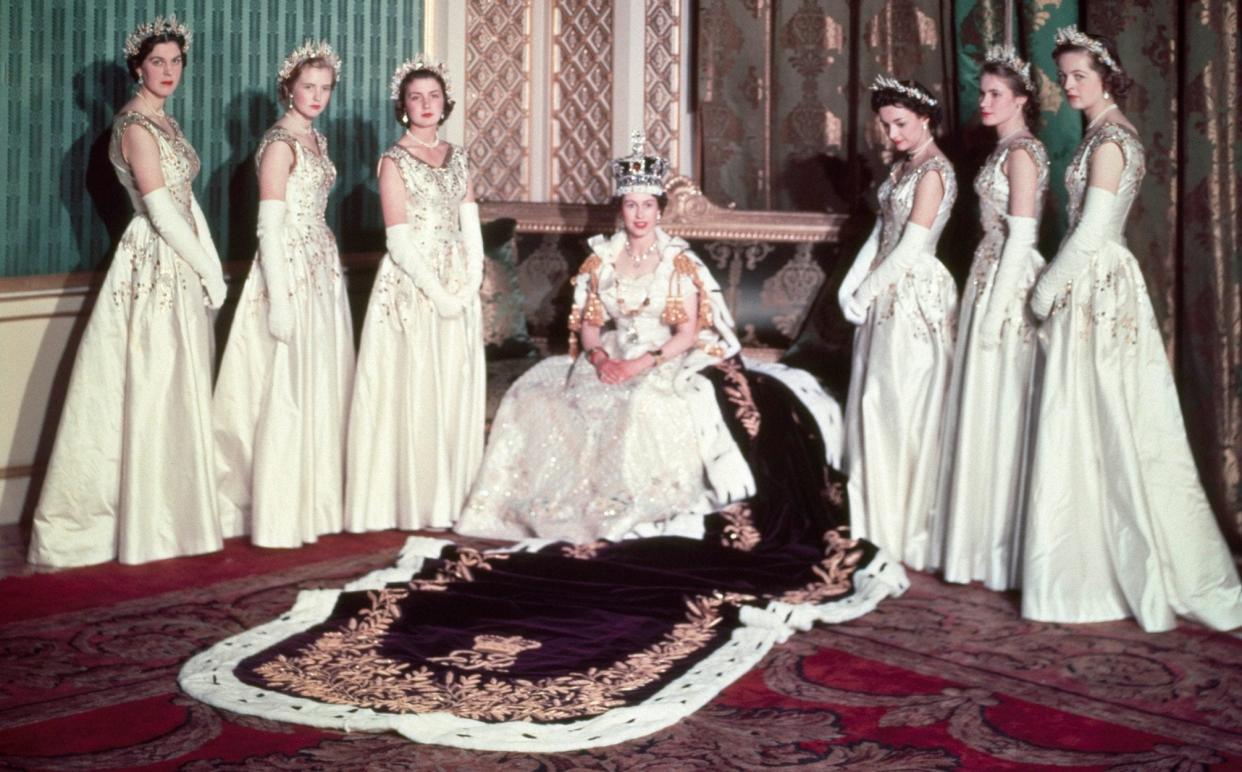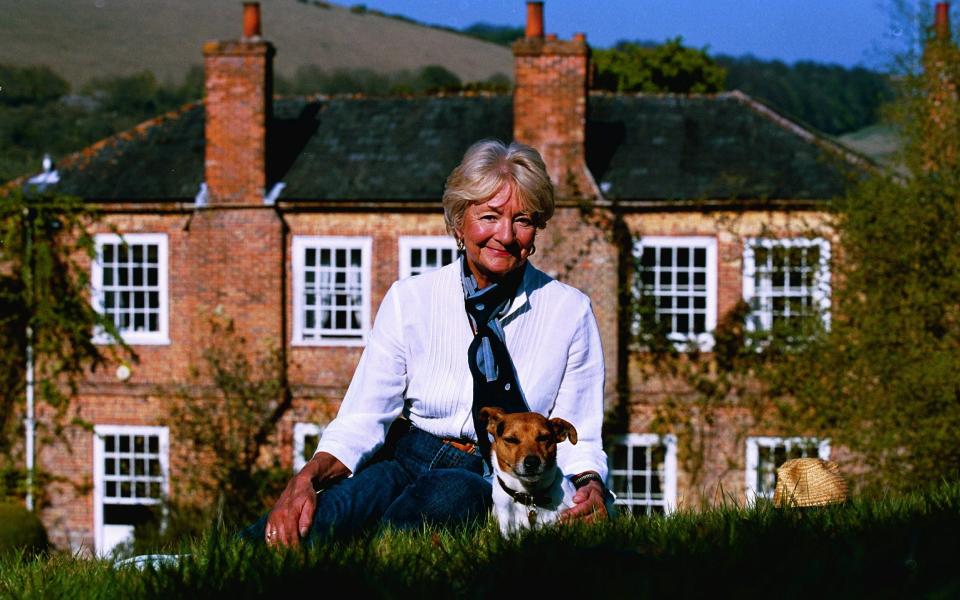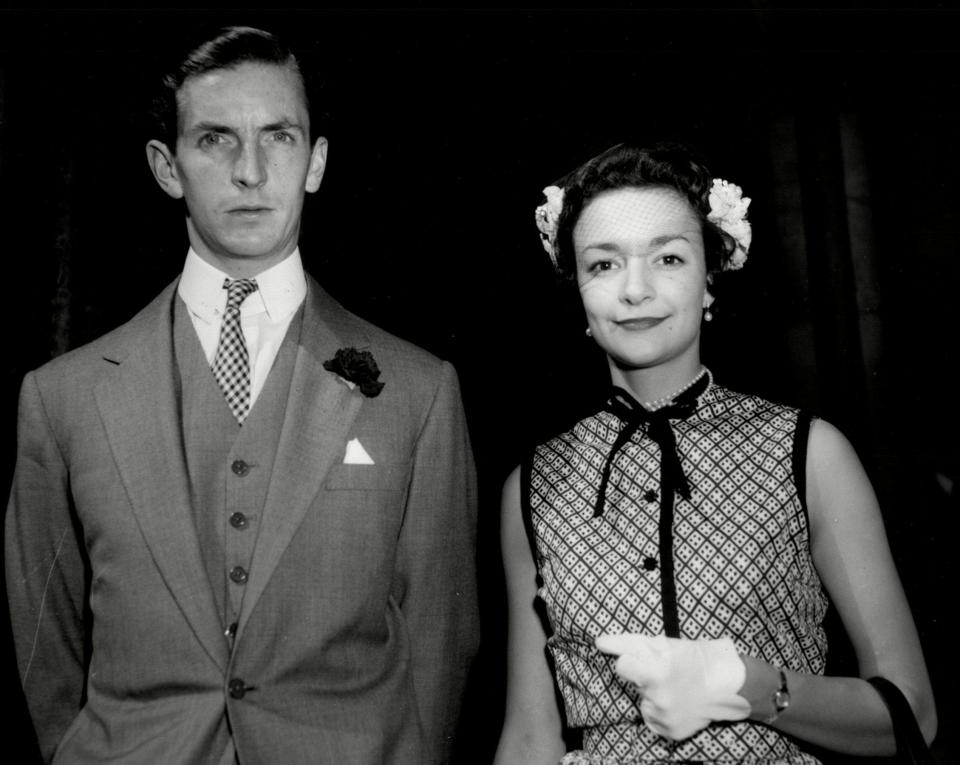Lady Mary Russell, maid of honour at Queen Elizabeth II’s Coronation – obituary

- Oops!Something went wrong.Please try again later.
- Oops!Something went wrong.Please try again later.
Lady Mary Russell, who has died aged 88, was one of the youngest maids of honour at the Coronation in 1953.
Aged just 19, Lady Mary Baillie-Hamilton, as she was then (daughter of the 12th Earl of Haddington), was one of six aristocratic girls who carried the Queen’s 21ft train from the Gold State Coach and up the aisle of Westminster Abbey to the waiting Archbishop of Canterbury.
The long crimson velvet train, edged with ermine from Canada and embroidered with wheatsheaves and olive branches in golden thread, was so weighty that the Queen could not move unaided. Six silk handles were sewn underneath for the maids of honour, who had to unfurl it from the coach.
Lady Mary was taken to the Abbey at 6 am. In the anteroom, they heard the news that Edmund Hillary had climbed Everest. Then, as the Gold State Coach approached, they heard a wall of sound.
With billions of eyes upon the maids of honour, the pressure was enormous. “We had to get the Queen out of the carriage at the Abbey, and then back in again in one piece, and then back out again at Buckingham Palace,” Lady Mary Russell told a newspaper. In 2013, in an episode of Radio 4’s The Reunion, she revealed: “It was an incredible moment, but all I could think about was how heavy the embroidery felt.”

Before the Queen started walking into the Abbey, she turned round and said: “Ready, girls?” As the smallest, Lady Mary walked closest to the Queen, on her right-hand side. The other maids of honour were Lady Moyra Hamilton, daughter of the 4th Duke of Abercorn; Lady Rosemary Spencer-Churchill, daughter of the 10th Duke of Marlborough; Lady Jane Vane-Tempest-Stuart, daughter of the 8th Marquess of Londonderry; Lady Anne Coke, daughter of the 5th Earl of Leicester; and Lady Jane Heathcote-Drummond-Willoughby, daughter of the 3rd Earl of Ancaster.
Lady Mary, like several of the other girls, had never met the Queen. Their invitations had been issued by the Duke of Norfolk, the Earl Marshal, who was in charge of the Coronation. “I was completely gobsmacked,” Lady Mary Russell recalled. She thought: “Gosh. Me? I was thrilled, very excited but also very apprehensive.”
The tradition since the time of Queen Victoria was that maids of honour should be the unmarried daughters, between the ages of 17 and 23, of earls, marquesses or dukes. “It was an accident of birth,” Lady Mary Russell soon realised. “I was a Scot and they needed one. I was the right age and they knew my parents.”

Lady Mary’s father, the Earl of Haddington, was a childhood friend of the Queen Mother, a fellow Scot. At the coronation of George VI in 1937 he had carried the Sceptre of the Dove, one of two sceptres handed to the new monarch.
The six maids of honour, all young and beautiful, became an object of press frenzy. “We were treated just like the Spice Girls,” recalled Lady Anne Coke, later Lady Glenconner. They only met the Queen on the day itself, June 2 1953. All their rehearsals had been with the Duke of Norfolk; in the Abbey, they had to adjust their step to the Queen’s slower pace.
Their gowns, like the Queen’s, were designed by Norman Hartnell. “While they looked exquisite they were the most horribly uncomfortable things to wear, and absolutely crushed our ribs. We were told to keep wriggling our toes to try and keep the circulation going,” Lady Glenconner said. In their gloves were vials of ammonia, to break if they felt faint.

Lady Mary Russell was struck by the Queen’s composure: she was “completely serene. Yet she looked incredibly vulnerable, incredibly young, and I think we all felt, boy, she is taking on a big job.” After the reception, she gave each of the six girls “the most simple, beautiful brooch of her initials in her handwriting in diamonds,” said Lady Mary. “I went outside the Palace with friends, and cheered and cheered so many times. I felt pretty flat afterwards.”
Lady Mary Baillie-Hamilton was born in London on January 13 1934 to George Baillie-Hamilton, 12th Earl of Haddington, and his wife Sarah Cook, a flamboyant Canadian beauty who was instrumental in founding the Edinburgh Festival. Their seat is Mellerstain, a castellated Robert Adam house of famous beauty in the Borders, near Kelso. A brother, John, was born there in 1941. In winter, they would skate and curl on the frozen lake.
The family also owned another mansion, Tyninghame in East Lothian, at the mouth of the Tyne. It was there in the sand dunes that Lady Mary, an attractive girl who had inherited her mother’s creative flair, would film her friends on a cine camera, making their own versions of famous movies.

Her mother brought her up to be Catholic, and musical. She was home-schooled by a French governess from the ages of 10 until 13, when she was sent to Mayfield convent school in East Sussex. As a teenager, she could be found cutting pictures of famous baritones out of magazines. At 16 she went to a Parisian finishing school, where she was instructed in the piano by the composer Nadia Boulanger. She then worked at the Turner Archive of the Tate Gallery.
Her taste, like her mother’s was impeccable and she dressed with enviable style: “She was terribly attractive, wore the most unusual clothes,” her friend the Countess of Airlie recalled. “[But] she never showed off. She played it all very quietly.” In the 1980s, she founded a successful traditional silk screen printing business called Combe Manor Fabrics, which regularly exhibited at fairs like Decorex, and became a director of Whitchurch Silk Mill.
Lady Mary observed with amused indulgence as her brother, who succeeded as the 13th Earl of Haddington in 1985, established himself an authority on ghosts and crop circles. She was not bitten by the paranormal bug, however.

In 1954 she married the businessman Adrian Bailey, of the Rockware Glass family, but divorced him to marry David Russell, a landowner in Berkshire, in 1965.
He was a gifted pianist who entertained her with Broadway tunes, and at the barn of their house, Combe Manor, they made a small theatre in which they staged concerts of anything from Pergolesi arias (for which they commissioned new translations) to the jazzy numbers of George Gershwin, Irving Berlin and Jerome Kern. She was also a superb gardener, and prominent in the NSPCC.
Lady Mary Russell died on the eve of Queen Elizabeth’s state funeral. She is survived by her husband, and by a daughter and two sons of her first marriage and a daughter and son of her second.
Lady Mary Russell, born on January 13 1934, died September 18 2022

